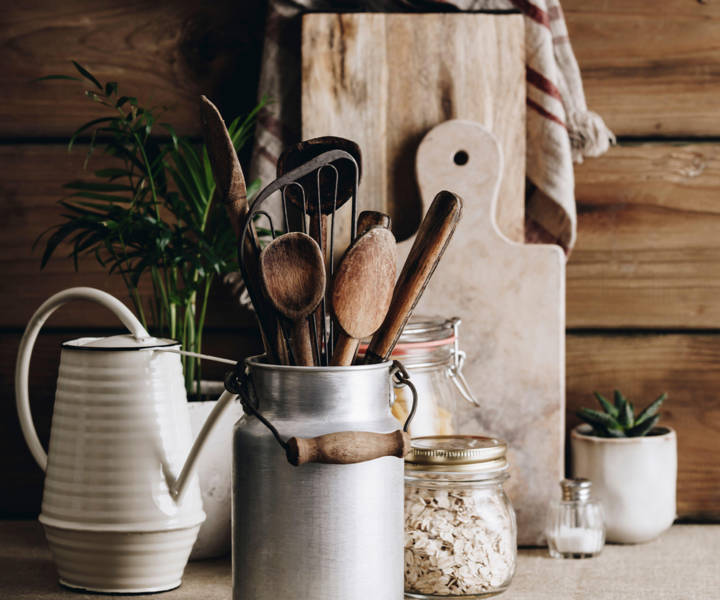Food
12 ways to be a more conscious cook in 2022
by Rebecca Seal

Want to live more sustainably? Try these planet-friendly ideas for shopping, cooking and eating more consciously
1. Use fewer pans
‘Even now, my mum screams at the telly if she sees a chef boiling lots of different things in different pans. She taught me to add vegetables to the pasta or rice pan at the end of cooking, or to steam them on top,’ says Melissa Hemsley, author of Eat Green: Delicious Flexitarian Recipes for Planet-friendly Eating (Ebury, £25). ‘That way you don’t lose the nutrients and there’s less washing up… and I hate washing up!’
2. Don't wrap
There’s often no need to use cling film or foil to store leftover food. Pop leftovers in a bowl and cover with a plate in the fridge – or use beeswax wraps for things like cheese or sandwiches.
3. Put a lid on it
Covering a pan with a lid can save up to 40% of the energy normally used and can halve the time it takes water to boil (although it’s more efficient to boil cooking water in a kettle first). Use the right ring, too – using a big ring for a small pan means heat energy gets lost.
4. Keep things fresh
‘If you buy bagged salad, put a dry paper towel inside it to absorb moisture, which can help prevent salad going slimy before you can eat it,’ says Karen Edwards, author of The Planet-Friendly Kitchen: How to Shop and Cook With a Conscience. ‘Store strawberries in an airtight jar in the fridge, to keep them crisp for longer – take out any squishy ones and freeze for smoothies. Store bananas, apples and onions away from other fruits and vegetables, as they speed up ripening and spoiling.’
5. Banish bags
When buying loose produce like broccoli, courgettes or even potatoes, you don’t really need a bag of any kind – just weigh the vegetables and keep the sticker to scan when you pay, then wash as normal when you get home.
6. Stuff the oven
If the oven has to be on, try to fill it up to make the most of the energy it is using – roast any vegetables going wrinkly in the bottom of the fridge, or make double quantities of dinner to go in the freezer.
7. Eat small prawns
‘Some wild prawn fisheries can have five to 10 kilos of bycatch per kilo of large prawns; as this happens in the tropics, that includes seahorses, manta rays, turtles – things you don’t want to be killing,’ says Jack Clarke, sustainable seafood advocate at the Marine Conservation Society. ‘But little cold-water prawns are from a well-managed, MSC (blue tick)-certified fishery and there's very little bycatch, so they're a good choice.’
8. Choose good fish
Use the MCS Good Fish Guide (mcsuk.org/goodfishguide) to check whether the fish you’re buying is rated green (do buy), yellow (okay to buy) or red (definitely don’t buy). If a label doesn’t tell you enough – on a fish pie it might say something like ‘white fish’ – then consider buying something else, or cooking from scratch.
9. Eat less meat
‘Cutting down on meat has a much greater impact than eating a lot of “sustainable” meat,’ says Kate Bratskeir, journalist and author of The Pocket Guide to Sustainable Food Shopping (Tiller Press, £9.99). ‘If you want to eat less meat, try choosing a day of the week, like meat-free Monday, or decide to only eat meat when you're dining out.’
10. Check your kit
- Use reusable food bags, like Stasher bags, which seal easily and go in the dishwasher.
- Get an aerator for the kitchen tap to cut water use.
- Buy only heavy-duty enamel, steel, glass or ceramic cookware, rather than non-stick pans that will wear out faster.
- Use eco-friendly soap for washing up and water plants with the leftovers.
- Skip the kitchen towel and wipe up with washable cloths instead.
11. Shut that door
Cold air falls straight out of vertical fridges and freezers, so save energy by keeping them shut as much as possible. Opening the oven forces hot air out, meaning cooking takes longer and uses more carbon.
12. Use up scraps
In my freezer I have a chicken-bones bag and a veg-scraps bag,’ says food writer Melissa Thompson (fowlmouths.co.uk). ‘They're for stock, and I add constantly – wing tips, skin and chicken carcasses to the bone bag, and trimmings for the veg bag. Once full, I make stock for risottos and soup. It means I use every little bit of any chicken and no veg goes to waste.’












